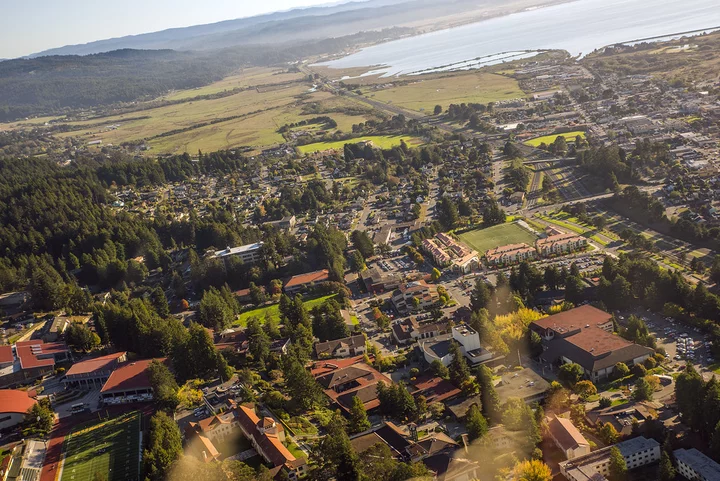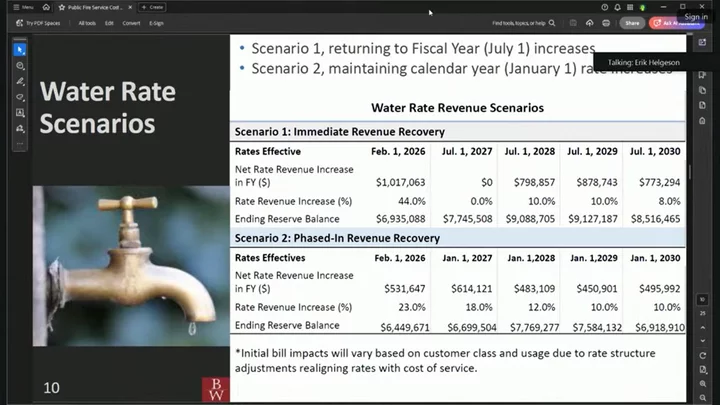Courtesy of Cal Poly Humboldt.
Big night at Arcata’s city council meeting yesterday, so no ado.
State hands down new RHNA numbers
Every so often, the state of California sends every jurisdiction in the state a number of housing units by income level that must be planned for. Called the Regional Housing Needs Allocation (RHNA), the process repeats every eight years. If they’re not planned for, the state can pull funding, developers can ignore zoning laws, huge fines are leveled — it’s a burden. California released the requirements for the 2027-2035 cycle in July, and Humboldt County and the city governments have now started planning how best to distribute and construct all 5,692 of the new units by 2035. Arcata’s deputy director of the community development department, Jennifer Dart, updated the council last night on how they’re trying to accomplish the task.
Dart said Arcata was willing to take 1,042 of them. It’s a big increase from the last cycle; Arcata only had to build 610 units then. Much of the increase is coming from new housing for those making 80% or less of Humboldt’s median income. California added two new categories for this cycle: “Acutely low” (0-15% of Humboldt’s median income) and “extremely low” (15-30%), totalling 225 more units. Above moderate housing for residents who make over 120% of the median income also increased 151 units.
It’ll be a tough challenge to meet, Dart said. It’ll be hard to come up with a way to fund so much housing for people who might not be able to pay for it — especially when state and federal funding for affordable housing is being reduced, and homeless shelters don’t count for RHNA.
Additionally, although Cal Poly Humboldt’s new Hinarr Hu Moulik dorms house almost 1,000 people, they can’t count them towards any income level — plus, it filled up a large site that could have made a great infill project, which is Arcata’s main strategy to keep up with the state’s mandate along with accessory dwelling units and deconstruction and remodeling. There’s not a lot of vacant land left in Arcata, Dart said, and the city has no desire to start sprawling out.
“What can we do?” Dart asked. “We’re going to get creative, because we are creative. I think Arcata continues to be a forward-thinking community.”
But long-term, Dart and a few of the city council members agreed that Humboldt needs to push for reform to the RHNA system, which doesn’t consider that many rural populations are declining in number and may not need to build more housing.
“We’re very pro-housing, and we want to provide more housing,” councilmember Stacy Atkins-Salazar said. “But it also needs to be done in a way that is achievable…it’ll be a long journey and we’re just starting to make noise about it.”
Water bills
Long story short: they’re going up. When that happens will be up to the city council next month. They’re either going to jack them up immediately and keep the price the same for a few years before doing it again, or it’ll happen a little more evenly.
Why? Well, Arcata’s water fund is drying up, and needs more revenue. Arcata is going to sink about $36 million into various improvement projects in the next five years. Much of that money will be borrowed, but the finance department would like to minimize that as much as possible.
Either the rates will go up 44% in February, followed by a few years of 10% increases for a total balance of $8.5 million in 2030, or they will be increased by 23% and followed by several increases between 10-18%, winding up around $6.9 million in 2030.
Customers’ fixed charges will either rise from $12.23 monthly to $23.58 or $24.65, depending on which way the council decides to swing. The price per hundred cubic feet will go up to either $13.50 or $14.12 from the current $7.15.
In 2028, single-family residences will be charged a flat rate for their sewer bill and on average will save about $2 a month. Commercial accounts will still be charged for their total usage.
Right now the average single-family household in Arcata pays $136.93 monthly for all of their water usage. By 2030, they’ll pay either $155.94 if the city council decides they want more money upfront, or $145.81 if they decide to be a little more patient.
There will be a public hearing on the subject Jan. 7.
Roger’s Garage project
The city council unanimously decided to award a $155,000 contract to environmental reviewer Helix to do an environmental impact report on the Roger’s Garage site, where a proposed low-income apartment complex could be built. Quite a few Bayside residents came to complain about the review, which they didn’t think was general enough for a contaminated site near an elementary school. Director of Community Development David Loya disagreed.
“We make decisions we think is necessary for levels of public disclosure,” Loya said. “We asked for a focused EIR because that’s where we’re going to land. The community does not determine that…I have some experience in this field, and based on that experience, I think we’ll be fine with a focused EIR.”
Other stuff
Humboldt Made got $5,000 for an ad campaign and City Manager Merritt Perry, in a brief aside, said there a Cal Poly Humboldt student was interested in drafting guidelines for a sister city project with a city around the same size as Arcata and Camoapa, Arcata’s sister city in Nicaragua.


CLICK TO MANAGE